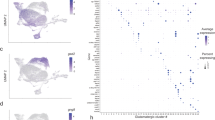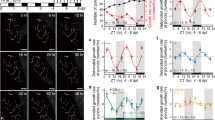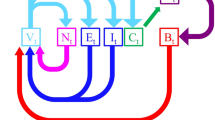Abstract
Spontaneous activity generated in the retina is necessary to establish a precise retinotopic map, but the underlying mechanisms are poorly understood. We demonstrate here that neural activity controls ephrin-A–mediated responses. In the mouse retinotectal system, we show that spontaneous activity of the retinal ganglion cells (RGCs) is needed, independently of synaptic transmission, for the ordering of the retinotopic map and the elimination of exuberant retinal axons. Activity blockade suppressed the repellent action of ephrin-A on RGC growth cones by cyclic AMP (cAMP)-dependent pathways. Unexpectedly, the ephrin-A5–induced retraction required cAMP oscillations rather than sustained increases in intracellular cAMP concentrations. Periodic photo-induced release of caged cAMP in growth cones rescued the response to ephrin-A5 when activity was blocked. These results provide a direct molecular link between spontaneous neural activity and axon guidance mechanisms during the refinement of neural maps.
This is a preview of subscription content, access via your institution
Access options
Subscribe to this journal
Receive 12 print issues and online access
$209.00 per year
only $17.42 per issue
Buy this article
- Purchase on Springer Link
- Instant access to full article PDF
Prices may be subject to local taxes which are calculated during checkout






Similar content being viewed by others
References
Feldheim, D.A. et al. Genetic analysis of ephrin-A2 and ephrin-A5 shows their requirement in multiple aspects of retinocollicular mapping. Neuron 25, 563–574 (2000).
Brunet, I. et al. The transcription factor Engrailed-2 guides retinal axons. Nature 438, 94–98 (2005).
Sretavan, D.W., Shatz, C.J. & Stryker, M.P. Modification of retinal ganglion cell axon morphology by prenatal infusion of tetrodotoxin. Nature 336, 468–471 (1988).
McLaughlin, T., Torborg, C.L., Feller, M.B. & O'Leary, D.D. Retinotopic map refinement requires spontaneous retinal waves during a brief critical period of development. Neuron 40, 1147–1160 (2003).
Torborg, C.L. & Feller, M.B. Spontaneous patterned retinal activity and the refinement of retinal projections. Prog. Neurobiol. 76, 213–235 (2005).
Pfeiffenberger, C. et al. Ephrin-As and neural activity are required for eye-specific patterning during retinogeniculate mapping. Nat. Neurosci. 8, 1022–1027 (2005).
Fields, R.D. Regulation of neurite outgrowth and immediate early gene expression by patterned electrical stimulation 44. Prog. Brain Res. 103, 127–136 (1994).
Ming, G., Henley, J., Tessier-Lavigne, M., Song, H. & Poo, M. Electrical activity modulates growth cone guidance by diffusible factors. Neuron 29, 441–452 (2001).
Hanson, M.G. & Landmesser, L.T. Normal patterns of spontaneous activity are required for correct motor axon guidance and the expression of specific guidance molecules. Neuron 43, 687–701 (2004).
Cline, H. Sperry and Hebb: oil and vinegar? Trends Neurosci. 26, 655–661 (2003).
Wong, R.O., Meister, M. & Shatz, C.J. Transient period of correlated bursting activity during development of the mammalian retina. Neuron 11, 923–938 (1993).
Huberman, A.D. et al. Eye-specific retinogeniculate segregation independent of normal neuronal activity. Science 300, 994–998 (2003).
Kolls, B.J. & Meyer, R.L. Spontaneous retinal activity is tonic and does not drive tectal activity during activity-dependent refinement in regeneration. J. Neurosci. 22, 2626–2636 (2002).
Drescher, U. et al. In vitro guidance of retinal ganglion cell axons by RAGS, a 25 kDa tectal protein related to ligands for Eph receptor tyrosine kinases. Cell 82, 359–370 (1995).
Feldheim, D.A. et al. Topographic guidance labels in a sensory projection to the forebrain. Neuron 21, 1303–1313 (1998).
Simon, D.K. & O'Leary, D.D. Development of topographic order in the mammalian retinocollicular projection. J. Neurosci. 12, 1212–1232 (1992).
Nicol, X., Muzerelle, A., Rio, J.P., Metin, C. & Gaspar, P. Requirement of adenylate cyclase 1 for the ephrin-A5–dependent retraction of exuberant retinal axons. J. Neurosci. 26, 862–872 (2006).
Fagan, K.A., Graf, R.A., Tolman, S., Schaack, J. & Cooper, D.M. Regulation of a Ca2+-sensitive adenylyl cyclase in an excitable cell. Role of voltage-gated versus capacitative Ca2+ entry. J. Biol. Chem. 275, 40187–40194 (2000).
Bansal, A. et al. Mice lacking specific nicotinic acetylcholine receptor subunits exhibit dramatically altered spontaneous activity patterns and reveal a limited role for retinal waves in forming ON and OFF circuits in the inner retina. J. Neurosci. 20, 7672–7681 (2000).
Verhage, M. et al. Synaptic assembly of the brain in the absence of neurotransmitter secretion. Science 287, 864–869 (2000).
Simon, D.K., Prusky, G.T., O'Leary, D.D. & Constantine-Paton, M. N-methyl-D-aspartate receptor antagonists disrupt the formation of a mammalian neural map. Proc. Natl. Acad. Sci. USA 89, 10593–10597 (1992).
Ruthazer, E.S., Akerman, C.J. & Cline, H.T. Control of axon branch dynamics by correlated activity in vivo. Science 301, 66–70 (2003).
Demarque, M. et al. Paracrine intercellular communication by a Ca2+- and SNARE-independent release of GABA and glutamate prior to synapse formation. Neuron 36, 1051–1061 (2002).
Colonnese, M.T. & Constantine-Paton, M. Chronic NMDA receptor blockade from birth increases the sprouting capacity of ipsilateral retinocollicular axons without disrupting their early segregation. J. Neurosci. 21, 1557–1568 (2001).
Spitzer, N.C., Lautermilch, N.J., Smith, R.D. & Gomez, T.M. Coding of neuronal differentiation by calcium transients. Bioessays 22, 811–817 (2000).
Goldberg, J.L. et al. Retinal ganglion cells do not extend axons by default: promotion by neurotrophic signaling and electrical activity. Neuron 33, 689–702 (2002).
Thies, E. & Davenport, R.W. Independent roles of Rho-GTPases in growth cone and axonal behavior. J. Neurobiol. 54, 358–369 (2003).
Jalink, K. et al. Inhibition of lysophosphatidate- and thrombin-induced neurite retraction and neuronal cell rounding by ADP ribosylation of the small GTP-binding protein Rho. J. Cell Biol. 126, 801–810 (1994).
Song, H. et al. Conversion of neuronal growth cone responses from repulsion to attraction by cyclic nucleotides. Science 281, 1515–1518 (1998).
Ravary, A. et al. Adenylate cyclase 1 as a key actor in the refinement of retinal projection maps. J. Neurosci. 23, 2228–2238 (2003).
Gorbunova, Y.V. & Spitzer, N.C. Dynamic interactions of cyclic AMP transients and spontaneous Ca(2+) spikes. Nature 418, 93–96 (2002).
Dunn, T.A. et al. Imaging of cAMP levels and protein kinase a activity reveals that retinal waves drive oscillations in second-messenger cascades 1. J. Neurosci. 26, 12807–12815 (2006).
Luo, L. & O'Leary, D.D. Axon retraction and degeneration in development and disease. Annu. Rev. Neurosci. 28, 127–156 (2005).
Hooks, B.M. & Chen, C. Distinct roles for spontaneous and visual activity in remodeling of the retinogeniculate synapse. Neuron 52, 281–291 (2006).
Sachs, G.M., Jacobson, M. & Caviness, V.S., Jr. Postnatal changes in arborization patterns of murine retinocollicular axons. J. Comp. Neurol. 246, 395–408 (1986).
Stellwagen, D. & Shatz, C.J. An instructive role for retinal waves in the development of retinogeniculate connectivity. Neuron 33, 357–367 (2002).
Cook, P.M., Prusky, G.T. & Ramoa, A.S. The role of spontaneous retinal activity before eye opening in the maturation of form and function in the retinogeniculate pathway of the ferret. Vis. Neurosci. 16, 491–501 (1999).
Hua, J.Y., Smear, M.C., Baier, H. & Smith, S.J. Regulation of axon growth in vivo by activity-based competition. Nature 434, 1022–1026 (2005).
Uesaka, N., Hirai, S., Maruyama, T., Ruthazer, E.S. & Yamamoto, N. Activity dependence of cortical axon branch formation: a morphological and electrophysiological study using organotypic slice cultures. J. Neurosci. 25, 1–9 (2005).
Fields, R.D., Neale, E.A. & Nelson, P.G. Effects of patterned electrical activity on neurite outgrowth from mouse sensory neurons. J. Neurosci. 10, 2950–2964 (1990).
Gomez, T.M. & Spitzer, N.C. In vivo regulation of axon extension and pathfinding by growth-cone calcium transients. Nature 397, 350–355 (1999).
Willoughby, D. & Cooper, D.M. Ca2+ stimulation of adenylyl cyclase generates dynamic oscillations in cyclic AMP. J. Cell Sci. 119, 828–836 (2006).
Cooper, D.M., Mons, N. & Karpen, J.W. Adenylyl cyclases and the interaction between calcium and cAMP signalling. Nature 374, 421–424 (1995).
Nicol, X. et al. Role of the calcium modulated cyclases in the development of the retinal projections. Eur. J. Neurosci. 24, 3401–3414 (2006).
Howe, A.K. Regulation of actin-based cell migration by cAMP/PKA. Biochim. Biophys. Acta 1692, 159–174 (2004).
Yuan, X.B. et al. Signalling and crosstalk of Rho GTPases in mediating axon guidance. Nat. Cell Biol. 5, 38–45 (2003).
Sahin, M. et al. Eph-dependent tyrosine phosphorylation of ephexin1 modulates growth cone collapse. Neuron 46, 191–204 (2005).
Ooashi, N. et al. Cell adhesion molecules regulate Ca2+-mediated steering of growth cones via cyclic AMP and ryanodine receptor type 3. J. Cell Biol. 170, 1159–1167 (2005).
Gomez, T.M., Robles, E., Poo, M. & Spitzer, N.C. Filopodial calcium transients promote substrate-dependent growth cone turning. Science 291, 1983–1987 (2001).
Hadjantonakis, A.K., Gertsenstein, M., Ikawa, M., Okabe, M. & Nagy, A. Generating green fluorescent mice by germline transmission of green fluorescent ES cells. Mech. Dev. 76, 79–90 (1998).
Acknowledgements
We thank P. Vanderhaeghen for his help and advice concerning the ephrins, E. Welker for the gift of the brl mice and J.A. Girault, L. Maroteaux, C. Métin and V. Setola for discussions and suggestions. Part of this work was done at the Imaging core facility of Institut Fédératif de Recherche de Neurosciences de la Salpêtrière, with the expert help of C.M. Bachelet. This work was supported by grants from the Institut National de la Santé et de la Recherche Médicale, Agence Nationale de la Recherche (APV05187DSA), and Retina France. X.N. was supported by a grant from the Délégation Générale pour l'Armement. N.N.-N. was supported by a grant from Ligue Française Contre l'Epilepsie.
Author information
Authors and Affiliations
Contributions
X.N. participated in the design of the project, the writing of the manuscript and conducted the experiments; S.V., A.M. and N.N.-N. conducted crucial experiments with the cocultures and the collapse assays; T.C.S. generated the munc18-1−/− mice and helped in the design of the project and the writing of the manuscript; R.M. contributed to the electrophysiological experiments and helped to write the manuscript; P.G. supervised the project and wrote the manuscript.
Corresponding author
Ethics declarations
Competing interests
The authors declare no competing financial interests.
Supplementary information
Supplementary Fig. 1
Calculation of a refinement index of the retinal projections. (PDF 273 kb)
Supplementary Fig. 2
TTX does not increase cell death in the SC and in the retina. (PDF 60 kb)
Supplementary Fig. 3
Summary of results and proposed mechanisms. (PDF 242 kb)
Supplementary Video 1
TTX blocks the rearward movement of growth cone in response to ephrin-A5. (AVI 5423 kb)
Supplementary Video 2
Ephrin-A5 induced axon retraction, blocked by TTX, is rescued by periodic cAMP uncaging. (AVI 8159 kb)
Supplementary Video 3
cAMP oscillations do not induce modifications in axon growth or retraction by themselves. (AVI 2953 kb)
Rights and permissions
About this article
Cite this article
Nicol, X., Voyatzis, S., Muzerelle, A. et al. cAMP oscillations and retinal activity are permissive for ephrin signaling during the establishment of the retinotopic map. Nat Neurosci 10, 340–347 (2007). https://doi.org/10.1038/nn1842
Received:
Accepted:
Published:
Issue Date:
DOI: https://doi.org/10.1038/nn1842
This article is cited by
-
Subcellular second messenger networks drive distinct repellent-induced axon behaviors
Nature Communications (2023)
-
Guidance landscapes unveiled by quantitative proteomics to control reinnervation in adult visual system
Nature Communications (2022)
-
RIM1/2 in retinal ganglion cells are required for the refinement of ipsilateral axons and eye-specific segregation
Scientific Reports (2017)
-
A plasma membrane microdomain compartmentalizes ephrin-generated cAMP signals to prune developing retinal axon arbors
Nature Communications (2016)
-
Photoactivated adenylyl cyclase (PAC) reveals novel mechanisms underlying cAMP-dependent axonal morphogenesis
Scientific Reports (2016)



